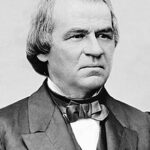President Andrew Johnson launched his Swing Around the Circle tour in August 1866. The campaign aimed to rally public support against Republican Reconstruction policies. Johnson planned to travel through major cities promoting his moderate approach to rebuilding the South. ⚠️
The Swing Around the Circle Decision
Johnson decided to personally campaign against the Fourteenth Amendment. He believed direct appeals to voters would pressure Congress. The tour would cover eighteen cities from Chicago to St. Louis. Johnson hoped to build a coalition of Democrats and moderate Republicans.
Campaign Strategy Gone Wrong
Johnson’s speeches quickly devolved into angry exchanges with hostile crowds. He abandoned prepared remarks for impromptu rants against Republican leaders. The president compared himself to Jesus Christ facing crucifixion. These outbursts shocked audiences expecting dignified presidential behavior. 🔥
Public Confrontations
Hecklers disrupted nearly every speech on the tour. Johnson engaged in shouting matches with crowd members. He called his opponents traitors and accused them of wanting his assassination. Newspapers reported these undignified exchanges across the nation. The tour portrayed Johnson as unstable and unpresidential. 📉
Impact:
The Swing Around the Circle tour devastated Johnson’s presidency and transformed American politics. His erratic behavior undermined public confidence in executive leadership. The campaign backfired spectacularly, strengthening his political opponents instead of building support.
Electoral Consequences
Republicans gained massive victories in the 1866 midterm elections. They secured veto-proof majorities in both houses of Congress. Johnson’s tour directly contributed to these Republican gains. Voters rejected his message and his behavior. The results gave Republicans complete control over Reconstruction policy. 📊
Presidential Authority Weakened
Johnson lost his ability to influence Reconstruction legislation. Congress passed increasingly radical measures over his vetoes. His public meltdowns destroyed his credibility with moderate Republicans. The tour accelerated his political isolation in Washington. It set the stage for his eventual impeachment proceedings. 🔥
Long-term Political Impact
The failed tour established new standards for presidential campaigning. Future presidents avoided Johnson’s confrontational approach with hostile crowds. It demonstrated the risks of undignified presidential behavior. The tour showed how personal conduct could undermine policy goals. Johnson’s failure influenced presidential communication strategies for generations. 📉
